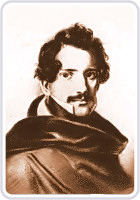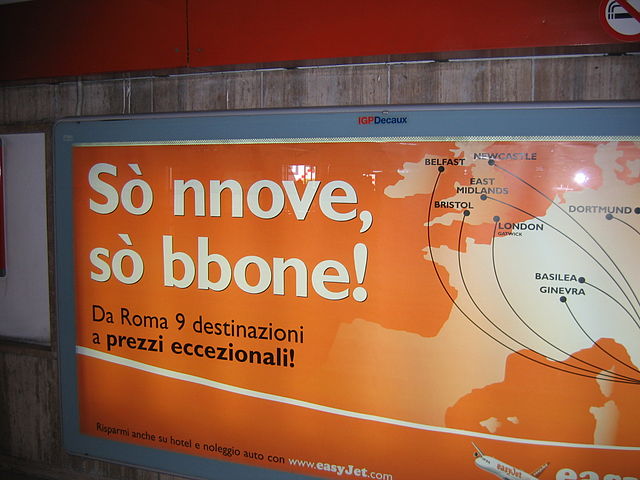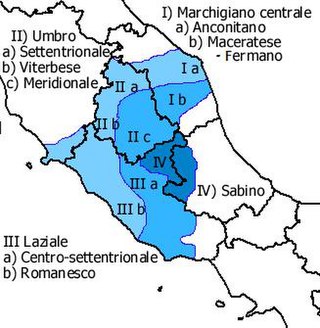Romanesco dialect
Dialect of Italian spoken in Rome From Wikipedia, the free encyclopedia
Romanesco (Italian pronunciation: [romaˈnesko]) is one of the Central Italian dialects spoken in the Metropolitan City of Rome Capital, especially in the core city. It is linguistically close to Tuscan and Standard Italian, with some notable differences from these two. Rich in vivid expressions and sayings, Romanesco is used in a typical diglossic setting, mainly for informal/colloquial communication, with code-switching and translanguaging with the standard language.
This article needs additional citations for verification. (October 2007) |
| Romanesco | |
|---|---|
| Romano | |
| Native to | Italy Vatican City |
| Region | Metropolitan City of Rome Capital, Lazio |
| Latin | |
| Language codes | |
| ISO 639-3 | – |
| Glottolog | None |
| Linguasphere | 51-AAA-rab |
 | |
History
Summarize
Perspective
First traces
The vernacular language of Rome, of which the short Commodilla catacomb inscription (9th century CE) might be considered the earliest attestation,[1] is believed to have been regarded as low-prestige,[2]: 10 as can be seen in the 11th-century Saint Clement and Sisinnius inscription, featuring a dialogue wherein the saint is given higher moral ground by juxtaposing his liturgical language with the common speech employed by Sisinnius and his servants.
Old Romanesco
The 13th century saw the first works of literature written in Roman vernacular, such as Storie de Troja et de Roma (Stories of Troy and of Rome, an anonymous translation of Multae historiae et Troianae et Romanae, a historical compilation by another anonymous author) and Le miracole de Roma (The marvels of Rome, translation of Mirabilia Urbis Romae), characterized by a coexistence of Latin and vernacular elements.
The status of the dialect as low-class was consolidated in the 1300s, when Dante Alighieri described it in his Latin essay De vulgari eloquentia as the worst one in Italy, a tristiloquium (“offensive speech”),[3] linking it to the uncouthness of the people, criticizing their custom of addressing even people commonly perceived as socially superior by using the informal pronoun tu, instead of formal voi[3] (something that had already been remarked by Salimbene di Adam in his chronicle,[4] written twenty-some years before).
The work that best represents this phase of the dialect is a chronicle—known in Italian as the Cronica dell'Anonimo Romano, and also by the title Vita di Cola di Rienzo (Life of Cola di Rienzo)—written in the latter half of the century by an anonymous Roman author.[5]
During the last decades of the 14th century, Romanesco came to be perceived, even among people of high social status, as having higher prestige than before, and started appearing in votive and burial inscriptions, as well as in notarial documents.[2]: 18–19
Features
An analysis published in 2022[6] presents the following as defining characteristics of old Roman vernacular.
Vowels
- Vowel breaking of original stressed ⟨e, o⟩ > /jɛ, wɔ/ e.g.:
- Lack of raising of stressed vowels before [ŋ] (e.g. lengua, “tongue”)
- Lack of raising of pretonic /e/ (e.g. de Roma; compare Tuscan di Roma)
- Conservation of unstressed /a/ when followed by a trill consonant (e.g. margarita; compare Tuscan margherita)
Consonants
- Assimilation
- progressive, e.g.:
- ⟨nd⟩ > /nn/: mundus > munno (“world”)
- ⟨mb, nv⟩ > /mm/: combattere > commattere (“to fight”); convertit > (se) commerte (“he/she/it changes”)
- ⟨ld⟩ > /ll/: cal(i)dus > callo (“hot”)
- regressive, e.g.:
- progressive, e.g.:
- Betacism
- ⟨b, v⟩ > /(b)b/ when geminated or preceded by a consonant other than /r/:
- abbelenare (“to poison”) (compare Tuscan avvelenare)
- ⟨b, v⟩ > /v/ when word-initial, postvocalic, or preceded by /r/:
- ⟨b, v⟩ > /(b)b/ when geminated or preceded by a consonant other than /r/:
- Palatalization
- Labiodentalization ⟨go-, gu-⟩ > /v/, e.g.:
- ⟨-mj-, -ng(e/i)-, -mbj-⟩ > /ɲɲ/
- Affrication of /s/ to /t͡s/ after /l, r, n/
- ⟨-rj-, -sj-⟩ > /r, s/, e.g.:
- Conservation of semiconsonantal ⟨i⟩, e.g.:
- iacet > iace (“[it] lies”) (compare It. giace, having undergone affrication)
- Paragogic syllable -ne appended to oxytones (words stressed on the last syllable), e.g.:
- è (“[he/she/it] is”) > ene
- Lack of voicing of voiceless plosives in intervocalic position, and between a vowel and a resonant:
- L-vocalization, e.g.:
Morphology
- Presence of nouns with plural endings -a, -ora (e.g. cervella, “brains”; tempora, “times”)
- Presence of nouns with plural ending -o, reflecting the Latin 4th-declension ending (e.g. mano, “hands”; compare Latin manūs)
- Presence of nouns with singular ending -e, reflecting the Latin 5th-declension ending (e.g. bellezze, “beauty”; implies Vulgar Latin *bellitjēm)
- lo as the masculine definite article (plural gli)
- 2nd- and 3rd-person singular possessive pronouns — tio (“your(s)”), sio (“his/her/its”) — analogically reshaped on the basis of mio (“my, mine”); compare Tuscan mio, tuo, suo
- Presence of enclitic personal possessive pronouns (e.g. patremo, “my father”)
- Accusative singular personal pronouns mi, ti, si (compare Tuscan me, te, sé)
- Presence of the numeral doi (“two”; compare Tuscan due)
- 3rd-person singular preterite endings -ao (1st conjugation), -eo (2nd conjugation), -io (3rd conjugation)
Early Modern period
Starting with the 16th century, the Roman dialect underwent an increasingly stronger influence from the Tuscan dialect (from which modern Italian derives) starting with the reigns of the two Medici popes (Leo X and Clement VII) and with the Sack of Rome in 1527, two events which provoked a large immigration from Tuscany.[7][8] Therefore, current Romanesco has grammar and roots that are rather different from other dialects in Central Italy.[8]
Modern Period

The path towards a progressive Tuscanization of the dialect can be observed in the works of the major Romanesco writers and poets of the past two centuries: Giuseppe Gioachino Belli (1791–1863), whose sonetti romaneschi represent the most important work in this dialect and an eternal monument to 19th century Roman people; Cesare Pascarella (1858–1940); Giggi Zanazzo (1860–1911); and Carlo Alberto Salustri (1871–1950), nicknamed Trilussa.
Diffusion

Before Rome became the capital city of Italy, Romanesco was spoken only inside the walls of the city, while the little towns surrounding Rome had their own dialects. Nowadays, these dialects have been replaced with a variant of Romanesco, which therefore is now spoken in an area larger than the original one. It slightly pervades the everyday language of most of the immigrants who live in the large city.[citation needed]
Pronunciation
Summarize
Perspective
Romanesco pronunciation and spelling differs from Standard Italian in these cases:
- /j/ (lengthened) is used where standard Italian uses [ʎ]. This [j] is spelt ⟨j⟩, a letter seldom used in present-day Italian. Compare Italian figlio [ˈfiʎʎo] "son" and Romanesco fijo [ˈfijːo] or fìo [ˈfio] thanks to assimilation;
- geminate /r/ ("rolled r" or alveolar trill) does not exist anymore: for example, azzurro [aˈdːzuːɾo]; (Italian: azzurro "light blue"), verrebbe [veˈɾebːe] (Italian: verrebbe "he/she would come").[9] A Roman pun recites: "Tera, chitara e guera, co' ddu' ere, sinnò è erore" (English: "Ground, guitar and war with two R's, otherwise there is a mistake"): ere and erore are also "wrong", as they are erre and errore in Standard Italian.[9] This phenomenon presumably developed after 1870, as it was not present in the classical 19th century Romanesco of Belli;[9]
- /l/ becomes /r/ before another consonant: sòrdi [ˈsɔɾdi], Italian soldi "money";
- in Romanesco, as in most Central and Southern Italian languages and dialects, /b/ and /dʒ/ are always geminated where permissible: e.g. libbro [ˈlibːɾo] for Standard Italian libro [ˈliːbro] "book", aggenda for agenda "diary, agenda".
- the dropping of vowels at the beginning of a word when followed by a nasal consonant (m, n, gn), for example 'nzomma (Standard Italian insomma), 'n (Standard Italian un/in), 'mparà (Standard Italian imparare), gni (Standard Italian ogni).[10]
- assimilation with different consonant groups. (typically a Central-Southern phenomenon) For example, /nd/ turns into /nn/ (Standard Italian quando turns into quanno), /ld/ turns into /ll/ (Standard Italian caldo turns into callo), /mb/ turns into /mm/ (Standard Italian piombo turns into piommo).
Quote
Ma nun c'è lingua come la romana |
But there is no language like the Roman one |
| —G. G. Belli, "Le lingue der monno" [Languages of the world][11] |
Noteworthy figures
Today, Romanesco is generally considered more of a regional idiom than a true language. Classical Romanesco, which reached high literature with Giuseppe Gioachino Belli, has disappeared.
External forces such as immigration and the dominance of Italian are playing a role in the dissolution.
Notable artists using Romanesco
This section of a biography of a living person needs additional citations for verification. (February 2025) |
- Ferruccio Amendola, voice actor
- Mario Brega, actor and comedian
- Enrico Brignano, comedian
- Franco Califano, lyricist, musician,
- Paola Cortellesi, actress
- Christian De Sica, actor and singer
- Carlo Emilio Gadda, author
- Elena Fabrizi, actor and cook
- Aldo Fabrizi, actor and director
- Sabrina Ferilli, actress
- Gabriella Ferri, singer
- Lando Fiorini, actor and singer
- Giuseppe Gioacchino Belli, poet
- Anna Magnani, actress
- Nino Manfredi, actor
- Tomas Milian, actor
- Enrico Montesano, actor and comedian
- Pier Paolo Pasolini, poet, film director, writer, actor and playwright
- Cesare Pascarella, poet, painter
- Ettore Petrolini, actor
- Gigi Proietti, actor, director and comedian
- Enzo Salvi, actor
- Alberto Sordi, actor and director
- Trilussa, poet (Carlo Alberto Salustri's pen name)
- Antonello Venditti, singer
- Carlo Verdone, actor and director
- Zerocalcare, comics author
- The anonymous writers of the Pasquinades posted on the talking statues of Rome use Italian, Romanesco or a mixture of both.[12]
See also
- Belli's The Sovrans of the Old World (1831)
References
Sources
External links
Wikiwand - on
Seamless Wikipedia browsing. On steroids.
